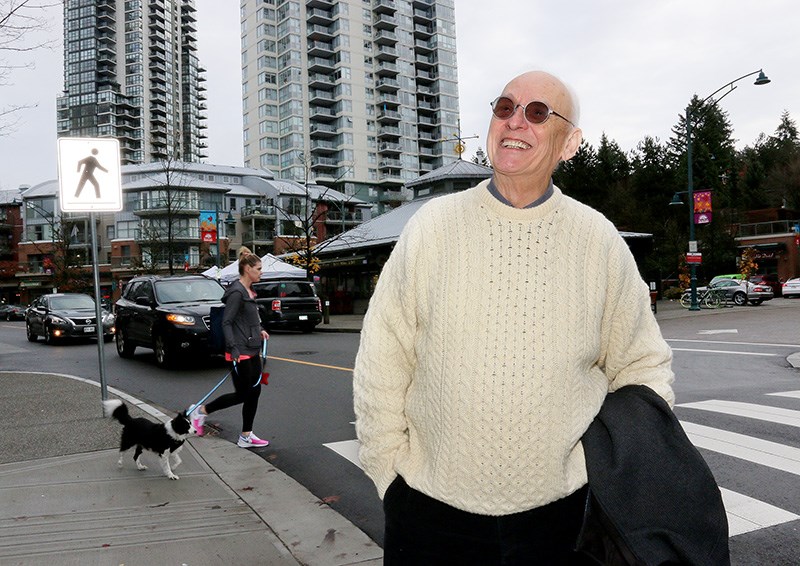As Port Moody residents consider the future of the neighbourhood around the Moody Centre SkyTrain station, and council prepares to move forward on ambitious plans to create vibrant mixed-use urban communities at Westport Village and the Flavelle sawmill property, former mayor Dave Driscoll can’t help but feel a sense of déjà vu.
Driscoll, who led the city from 1983 to ’93 and served as an alderman before that, heard all the current concerns about densification, walls of tall towers, traffic congestion and the threat new development poses to Port Moody’s “small-town character” before as the city pondered a plan to develop 13.5 acres of scrub land just east of the head of Burrard Inlet, where Ioco Road meets Guildford Way.
That piece of property became NewPort Village, a dense collection of more than 900 homes in highrise and low-rise buildings constructed along an internal roadway lined with retail shops, services and restaurants as well as a central square where a produce market and bakery are popular destinations.
According to Eric Vance, Port Moody’s director of planning from 1992 to ’95, the project ticks all the boxes of good urban design: It offers a variety of living spaces; there are employment opportunities in the project’s retail spaces as well as in the six-storey office building at the development’s gateway along Ioco Road; the variety of shops lining wide sidewalks protected by awnings and colonnades mean residents can access most of their daily needs just a short walk from their front door and encourages social interaction as they go about their errands.
But, said Vance, who still does consulting work for Port Moody and other cities, achieving those goals is the result of a series of serendipitous decisions as well as a solid spirit of collaboration between the city, the community and the developer.
“Let’s do something that looks right and feels right,” he said of the process.
Driscoll said the foundation for NewPort Village was actually put in place in the 1970s, when Port Moody’s north shore was identified as the city’s best potential area for future growth, and infrastructure such as roads, water and sewer lines were put in place to accommodate that.
Tying the city’s south and north shores together would be Inlet Centre and plans evolved to create a civic centre that included new recreation facilities, a fire hall, and moving the library and city hall from Moody Street.
Key to making that centre a vibrant, lively place would be development of the plot of property across Ioco Road that had been acquired in the 1980s by Nat Bosa, the patriarch of the Bosa family of developers.
“Decisions were going to be made that would extend beyond the term of my office,” Driscoll said.
As the community and council began discussing the future of the property, Driscoll said one theme was recurring: Residents wanted more housing options that could keep them in the community even as they downsized.
Vance said there was tremendous pressure on the city’s planning staff to get the new development right. So much so, that a year after a plan to build 800 homes — most of them in four highrises — and more than 200,000 sq. ft. of commercial space in a mall-like configuration was approved, the city and developer went back to the drawing board. Bosa wanted more density and less commercial space.
A new architect, John Perkins Sr. — who helped design Whistler Village as well as the CityGate project in Vancouver — was brought in. Instead of being stacked in a row along Guildford Way, five slightly shorter towers were scattered around the property’s periphery while low-rise condos along the project’s internal road network gave it a more human dimension. The retail component was scaled back to 70,000 sq. ft., most of it in smaller spaces on the ground floor of the low-rises.
From that framework came further refinements, Vance said. A decision to use green glass in the first condo tower — trendy in the early 1990s — was abandoned, as was a plan to leave the central square empty as a community gathering space for events under a glass canopy. Red brick was chosen as a component for exterior walls not only for its warm aesthetic but also to create an historical link to the city’s old Clayburn Brick factory. Tying it all together were green spaces, lighting, signage and seating areas designed by landscape architect Larry Diamond.
The result, Vance said, was a “largely inward-looking” enclave that looks contemporary and functions as a vibrant community more than 20 years after it was built. In fact, he still gives tours of NewPort Village to show it off to urban planners and architects looking to replicate its success.
Vance said that success was smoothed by being able to work with a single developer that shared the city’s vision for what the project should be.
“It’s a collaborative process,” he said. “There’s got to be give and take.”
Driscoll, enjoying a morning coffee in Gallagher’s in NewPort Village, said the project stands as a proud achievement of his political career. He said he likes that he can run into friends whenever he visits.
It shows what can be achieved when a council listens to residents and works cohesively alongside talented professionals and motivated developers, Driscoll said.
“This works as an organic place, it works functionally and it works economically,” he said, adding the city’s role was to “set the table.”



